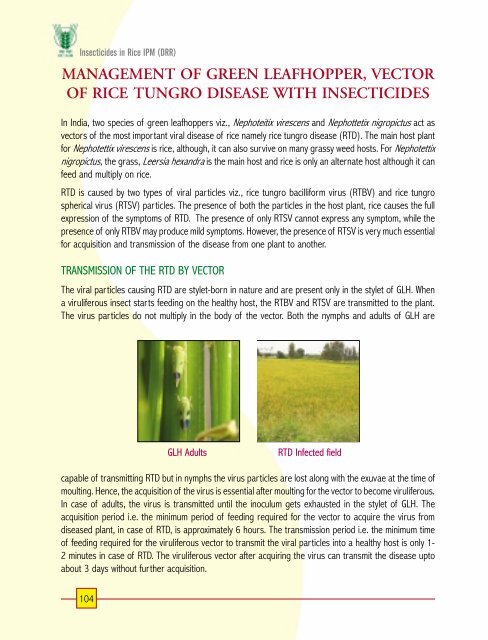priciples of insecticide use in rice ipm
priciples of insecticide use in rice ipm
priciples of insecticide use in rice ipm
Create successful ePaper yourself
Turn your PDF publications into a flip-book with our unique Google optimized e-Paper software.
Insecticides <strong>in</strong> Rice IPM (DRR)<br />
MANAGEMENT OF GREEN LEAFHOPPER, VECTOR<br />
OF RICE TUNGRO DISEASE WITH INSECTICIDES<br />
In India, two species <strong>of</strong> green leafhoppers viz., Nephoteitix virescens and Nephottetix nigropictus act as<br />
vectors <strong>of</strong> the most important viral disease <strong>of</strong> <strong>rice</strong> namely <strong>rice</strong> tungro disease (RTD). The ma<strong>in</strong> host plant<br />
for Nephotettix virescens is <strong>rice</strong>, although, it can also survive on many grassy weed hosts. For Nephotettix<br />
nigropictus, the grass, Leersia hexandra is the ma<strong>in</strong> host and <strong>rice</strong> is only an alternate host although it can<br />
feed and multiply on <strong>rice</strong>.<br />
RTD is ca<strong>use</strong>d by two types <strong>of</strong> viral particles viz., <strong>rice</strong> tungro bacilliform virus (RTBV) and <strong>rice</strong> tungro<br />
spherical virus (RTSV) particles. The presence <strong>of</strong> both the particles <strong>in</strong> the host plant, <strong>rice</strong> ca<strong>use</strong>s the full<br />
expression <strong>of</strong> the symptoms <strong>of</strong> RTD. The presence <strong>of</strong> only RTSV cannot express any symptom, while the<br />
presence <strong>of</strong> only RTBV may produce mild symptoms. However, the presence <strong>of</strong> RTSV is very much essential<br />
for acquisition and transmission <strong>of</strong> the disease from one plant to another.<br />
TRANSMISSION OF THE RTD BY VECTOR<br />
The viral particles caus<strong>in</strong>g RTD are stylet-born <strong>in</strong> nature and are present only <strong>in</strong> the stylet <strong>of</strong> GLH. When<br />
a viruliferous <strong>in</strong>sect starts feed<strong>in</strong>g on the healthy host, the RTBV and RTSV are transmitted to the plant.<br />
The virus particles do not multiply <strong>in</strong> the body <strong>of</strong> the vector. Both the nymphs and adults <strong>of</strong> GLH are<br />
104<br />
GLH Adults RTD Infected field<br />
capable <strong>of</strong> transmitt<strong>in</strong>g RTD but <strong>in</strong> nymphs the virus particles are lost along with the exuvae at the time <strong>of</strong><br />
moult<strong>in</strong>g. Hence, the acquisition <strong>of</strong> the virus is essential after moult<strong>in</strong>g for the vector to become viruliferous.<br />
In case <strong>of</strong> adults, the virus is transmitted until the <strong>in</strong>oculum gets exhausted <strong>in</strong> the stylet <strong>of</strong> GLH. The<br />
acquisition period i.e. the m<strong>in</strong>imum period <strong>of</strong> feed<strong>in</strong>g required for the vector to acquire the virus from<br />
diseased plant, <strong>in</strong> case <strong>of</strong> RTD, is approximately 6 hours. The transmission period i.e. the m<strong>in</strong>imum time<br />
<strong>of</strong> feed<strong>in</strong>g required for the viruliferous vector to transmit the viral particles <strong>in</strong>to a healthy host is only 1-<br />
2 m<strong>in</strong>utes <strong>in</strong> case <strong>of</strong> RTD. The viruliferous vector after acquir<strong>in</strong>g the virus can transmit the disease upto<br />
about 3 days without further acquisition.











